1. Hopscotch
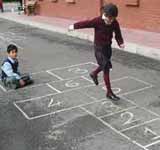
In different countries or regions it is known by other names such as the fight in Chile, "sweet tooth or airplane" in Colombia or the sambori in the Valencian Community. In some states of Mexico, it is known as "el avioncito" and in Peru, it is known as "mundo" and in North India it is known as "Pehlo Duggo". There are different ways of painting it on the ground, but the most common is this: it is painted, normally with chalk, a square on the ground, with the number 1 inside, then another square with two, another with three, ensuring that are equal. Then two squares are painted, one with the number four and next to it another with five. The top box is occupied by 6 and the last two are also double boxes with the numbers seven and eight, then another floor with a single box with the number 9. The game begins by throwing a small stone at square number 1, trying to make the stone fall into the square without touching the outer stripes. You begin to go through the hopscotch without stepping on the lines, keeping your balance until you reach the fourth floor where there are two boxes and we can support both feet (one on 4 and the other on 5).
2. Hide-and-seek
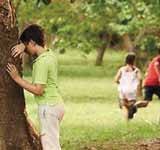
One person is the seeker and counts to an agreed number with their eyes closed, while the others hide. This can be outside on an area with many hiding places, such as a schoolyard, but with small children it is also very good to play indoors. After counting, the seeker shouts "Ready or not, I am coming!" and tries to find everyone who is hiding or the seeker has to wait after counting until he hears "Come on" after which he can start searching. An advantage of this is that the seeker immediately gets a hint where to look exactly. The game ends when everyone is found or when no one is searching anymore. Several variations are possible. A so-called stop location can be determined, where everyone who has been found must be reported. The seeker does this by "Buut (name of person)", usually followed by where the person is hiding. People who are hiding can also free-but-but at the pit by calling Buut Free. The last searched person can free-but everyone by Buut free for the whole pot "or" Buut free for the whole cabal.
3. Statues

The Statues (also known as Red Light, English Chicken, Green Light in the United States, and Grandmother's Footsteps) is children's game and variant of hide and seek popular with children around the world. One child is chosen as the "ox" and stands facing away from the other children on the "mountain" (for example in front of a wall). The other children stand in a row about 20 to 30 meters away from the ox. The ox calls out: "One - two - three - four - ox on the mountain." While he is counting, the children are allowed to move gradually towards the mountain. At the word "mountain" the ox turns around and all the children in the group have to remain petrified in their movement. If the ox catches a child in motion, it has to go back to the start. If the ox turns around before it has reached the start, it can start from the place where it is currently located. If a child manages to reach the mountain, they have won, that is, they can play the ox and the game starts all over again.
4. Skipping rope

Jumping rope is a child's play that can also be practiced as a sport. It can be played alone, with two or three people, or with a large group. In principle, there is no competition element, except in the sports rope skipping and Double Dutch. Only jumping rope is done with a rope about 2 meters long. A luxury skipping rope has handles made of wood or plastic in which the rope can rotate. The jumping person has one end in each hand, which is turned around. As soon as the rope hits the ground, it must have jumped up so that the rope can continue spinning. You can jump with two feet at the same time, but also "walking", with one foot at a time. This rope jumping is done with a rope of about 5 to 10 meters in length. Two children spin the rope, the third jumps in the middle. If there are only two children, one end is tied at hip height to, for example, a pole or tree. It takes practice to get together so that you can swing and jump at the right tempo. It is also difficult for the jumping person to jump into the rope circle at the right time.
5. Hurray
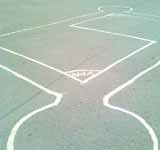
Hurray (also called boom, Kerr or Schmeiser) is a widespread children's game from the late 70s-80s of the 20th century. The game is played on a drawing drawn on asphalt or other paving. It involves two teams with an indefinite but equal number of players located in field no. 1 and field no. 2. The goal is one of the team could get out in the hallway outside the drawing, enter the opposing corridor and come up with the triangle in the corner of the opponent's box, shouting tow (respectively boom, hurray or submachine gun). While walking through the corridors, the player is not allowed to step on a line or outside the drawing, because it burns, that is, exits the game. Players from the opposing team - from their field or already out of the drawing - can pull or push it to make a line or go out of the drawing. When a player is in an open circle called a bomb, no one can pull or push him. Also, out-of-drawing players from opposing teams cannot collide with each other inside. In the late 80's the game gained mass popularity in Bulgaria for several years and on many streets and parking lots appeared drawings for the skin, made with oil paint.
6. Marbles
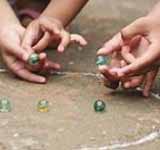
A marble is a small solid ball shape made of glass, marble, stone, wood, clay or plastic. Sometimes they are also made of metal. They are usually used by children to play marbles. The spherical shape of an ordinary marble has a diameter of about 1 to 2 cm. The larger specimens are usually up to 5 cm. Marbles is the competition game with marbles. There are several games. A popular game is where several participants take turns, starting from a distance, trying to throw a marble (while rolling on the ground) into a hole or marble pit. Attempts should be made to hit opponents' marbles so that they are further from the hole. The one with all the marbles in the hole first wins in the end. Often, but this also differs per region or school, points are awarded to the different types of marbles. Generally, larger marbles are worth more points than smaller ones, and rarer marbles with special color patterns more than "regular" glass marbles. This in turn has consequences for the use of marbles, because the bets of both sides must remain the same. Usually the marbles are played: the winner then wins all marbles. Children sometimes keep their marbles in a special bag: the marble bag.
7. Seven stones (Pittu Garam)
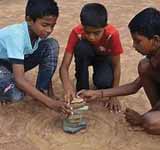
It is being played as two teams. A team must have at least five people. A team can have a maximum of twelve people. The team that wins the toss throws the ball. The ball used in this game, which is similar to the game of cricket, is called atta. Used for ball made of wool. A member of one team throws a ball at a pile of stones to knock them over. These stone pieces are called pithu. One can throw up to three times with ball. There may be a keeper standing behind the stones. The ball lands, and if the keeper catches it on the first jump, then the thrower loses the opportunity. After throwing the ball, they scatter on the field and the opposing team tries to throw them away. There are also rules for throwing the ball. Do not throw the ball below the knee and on the head. At this point, those who have dropped the dump should keep it in its original condition. When it is so collected, it is called 'pithu garam' loudly. Thus, if the entire team dumps and restores the ball without the opponent's ball, then the other team owes a debt.
8. Streetball (street basketball)

Streetball is a way of playing basketball. It is considered as another element of hip hop culture played especially in the basketball courts in parks, the "playgrounds", and deeply imitated by people from all over the world and of all ages. It has been launched to fame as part of the And1 show "Mix Tape Tour" throughout North America, which has promoted the game by the wide coverage it has achieved in the media. The rules put a greater emphasis on "head to head" between the attacker and the defender. In these, the attackers can deliver a large number of spectacular moves while trying to get to the basket, including changes of hands or feints, or other types of deception. Streetball often offers spectacular dunks or alley-oops, impressive movements with the ball, and, above all, a reigning good humor, a consequence of Streetball being born from games between friends. Some basketball rules, such as doubles, simply don't apply in Streetball.
9. Four square (Boxball)
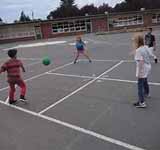
Four Square (also "four blocks") is a ball game played by four players on a square playing field with an exercise ball. It is a popular school playground game in the USA because hardly any material is needed, any number of players can take part in the game, the game rounds are short so that the game can be ended at any time, and the rules are easy to understand. A square playing field (4 to 7 m) divided into four equal squares. The individual squares are numbered from 1 to 4. An exercise ball (18 to 20 cm in diameter) or similar lightweight rubber balls. Each player tries to reach the first square and stay there. There is a player in each square. The other players stand in line next to the fourth square. The players in the square bounce the ball. As soon as a square player makes a mistake, player is eliminated and queues at the back of the line. This way the others rise in the hierarchy. Once bouncing, once hitting. If the ball falls into a player's field, player must hit the ball in another field. No other player may touch the ball. In the event of a mistake, the affected player is eliminated.
10. Backyard cricket (Gully cricket)
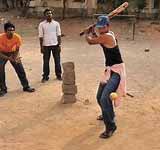
Backyard cricket, street cricket, beach cricket, gully cricket, informal and temporary variation of the game of cricket is cricket pavement. It is played for entertainment by people of all genders and all ages in gardens, backyards, on the street, in parks, on beaches and not for any purpose. Street cricket is a form of the sport of cricket that has less formal rules, and is played in a variety of locations. The South American plate and bete-ombro games are forms of street cricket. It is usually played with a tennis ball (which is less damaging to the body), and the wicket can be any object of a similar size, such as a trash can. Some possible rules - If the ball is batted, and it bounces once, it can still be caught to make the batter out, but needs to be caught with only one hand. If the ball is hit out of the field somewhere that is difficult to get into, you can score 6 runs as normal, but the batter is out as well. As in force play baseball, a batter may be put out for touching the wicket with any part of the body when the outfielder has the ball in his hand and the batter is not in his safe zone.
